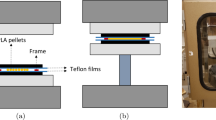Abstract
Polydimethyl siloxane (PDMS) based pressure sensitive adhesives (PSA) incorporating organo-clays at different loadings were fabricated via solution casting. Partially exfoliated nanocomposites were obtained for the hydroxyl terminated PDMS in ethyl acetate solvent as determined by X-ray diffraction and atomic force microscopy. Drug release studies showed that the initial burst release was substantially reduced and the drug release could be controlled by the addition of organo-clay. Shear strength and shear adhesion failure temperature (SAFT) measurements indicated substantial improvement in adhesive properties of the PSA nanocomposite adhesives. Shear strength showed more than 200% improvement at the lower clay loadings and the SAFT increased by about 21% due to the reinforcement provided by the nano-dispersed clay platelets. It was found that by optimizing the level of the organosilicate additive to the polymer matrix, superior control over drug release kinetics and simultaneous improvements in adhesive properties could be attained for a transdermal PSA formulation.





Similar content being viewed by others
References
Bharadwaj R. K. (2001) Modeling the barrier properties of polymer-layered silicate nanocomposites. Macromolecules 34: 9189–9192
Brown M. B., G. P. Martin, S. A. Jones, F. K. Akomeah (2006) Dermal and transdermal drug delivery systems: current and future prospects. Drug Deliv. 13: 175–187
Carslaw H. S., J. C. Jaeger (1959) Conduction of Heat in Solids. New York: Oxford Science Publications
Chou, C.-S., E. E. Lafleur, D. P. Lorah, R. V. Slone, and K. D. Neglia, US Patent 6838507, Rohm and Haas Company, 2005
Comyn J. (1985). Polymer Permeability. London, UK: Elsevier
Crank J. (1975) The Mathematics of Diffusion. Oxford, UK: Clarendon
Cypes Stephen H., W. M. Saltzman, P. Giannelis Emmanuel (2003) Organosilicate-polymer drug delivery systems: controlled release and enhanced mechanical properties. J. Control. Release 90: 163–169
Eitzmann D. M., R. R. Melkote, E. L. Cussler (1996) Barrier membranes with tipped impermeable flakes. AIChE J. 42: 2–9
Fu X., S. Qutubuddin (2001) Polymer-clay nanocomposites: exfoliation of organophilic montmorillonite nanolayers in polystyrene. Polymer 42: 807–813
Fu X. A., S. Qutubuddin (2005) Swelling behavior of organoclays in styrene and exfoliation in nanocomposites. J. Colloid Interface Sci. 283: 373–379
Giannelis E. P. (1996) Polymer layered silicate nanocomposites. Adv. Mater. 8: 29–35
Karande P., A. Jain, S. Mitragotri (2004) Discovery of transdermal penetration enhancers by high-throughput screening. Nat. Biotechnol. 22: 192–197
Karande P., A. Jain, S. Mitragotri (2006) Insights into synergistic interactions in binary mixtures of chemical permeation enhancers for transdermal drug delivery. J. Control. Release 115: 85–93
Krishnamoorti R., R. A. Vaia (eds) (2002) Polymer Nanocomposites: Synthesis, Characterization, and Modeling, Vol. 124. Oxford University Press, Washington, DC
LeBaron P. C., T. J. Pinnavaia (2001) Clay nanolayer reinforcement of silicone elastomer. Chem. Mater. 13: 3760–3765
Lee W. -F., Y. -C. Chen (2004). Effect of bentonite on the physical properties and drug-release behavior of poly(AA-co-PEGMEA)/bentonite nanocomposite hydrogels for mucoadhesive. J. Appl. Polymer Sci. 91: 2934–2941
Lofton, L. in PSTC Tech XXVII, Dahlquist Award Paper, http://www.pstc.org/papers/pdfs/lofton.pdf, Orlando, 2004
Naik A., Y. N. Kalia, R.H. Guy (2000). Transdermal drug delivery: overcoming the skin’s barrier function. Pharm. Sci. Technol. Today 3: 318–326
Nielsen L. E. (1967). Models for the permeability of filled polymer systems. J. Macromol. Sci. (Chem) A1: 929–942
Qutubuddin S., X. Fu Polymer-clay nanocomposites: synthesis and properties, In Rosoff M. (ed.) Nano-Surface Chemistry, Marcel Dekker Inc., New York, 2002
Ray S. S., M. Okamoto (2003). Polymer/layered silicate nanocomposites: a review from preparation to processing. Prog Polymer Sci 28: 1539–1641
Salvado N. V. I., V. V. Shah, D. A. Werkema (1999). Surfactants in pressure sensitive adhesives. Surf. Coatings Int. 82: 181–185
Schmidt D. F., F. Clement, E. P. Giannelis (2006). On the origins of silicate dispersion in polysiloxane/layered-silicate nanocomposites. Adv. Funct. Mater. 16: 417–425
Staskin D. R. (2003) Transdermal systems for overactive bladder: principles and practice. Rev. Urol. 5: S26–S30
Surber C., K. P. Wilhelm, D. Bermann, H. I. Maibach (1993). In vivo skin penetration of acitretin in volunteers using three sampling techniques. Pharm. Res. 10: 1291–1294
Takeuchi H., C. Cohen (1999) Reinforcement of poly(dimethylsiloxane) elastomers by chain-end anchoring to clay particles. Macromolecules 32: 6792–6799
Teh P. L., Z. A. M. Ishak, A. S. Hashim, J. Karger-Kocsis, U. S. Ishiaku (2006). Physical properties of natural rubber/organoclay nanocomposites compatibilized with epoxidized natural rubber. J. Appl. Polymer Sci. 100: 1083–1092
Venkatraman S., R. Gale (1998) Skin adhesives and skin adhesion. 1. Transdermal drug delivery systems. Biomaterials 19: 1119–1136
Willhelm K. P., K. Surber, H. I. Maibach (1991). Effect of sodium lauryl sulfate induced skin irrigation on in vivo percutaneous penetration of four drugs. J. Invest. Dermatol. 97: 927–932
Xu R., E. Manias, A. J. Snyder, J. Runt (2001). New biomedical poly(urethane urea) layered silicate nanocomposites. Macromolecules 34: 1989–1992
Acknowledgment
The research was supported in part by a grant from the National Institutes of Health (EB006203).
Author information
Authors and Affiliations
Corresponding author
Rights and permissions
About this article
Cite this article
Shaikh, S., Birdi, A., Qutubuddin, S. et al. Controlled Release in Transdermal Pressure Sensitive Adhesives using Organosilicate Nanocomposites. Ann Biomed Eng 35, 2130–2137 (2007). https://doi.org/10.1007/s10439-007-9369-8
Received:
Accepted:
Published:
Issue Date:
DOI: https://doi.org/10.1007/s10439-007-9369-8




